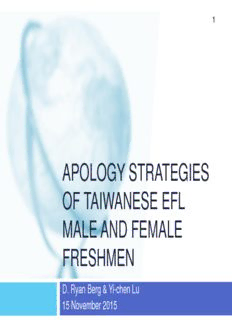
Apology Strategies of Taiwanese EFL Male and Female Freshmen PDF
Preview Apology Strategies of Taiwanese EFL Male and Female Freshmen
1 APOLOGY STRATEGIES OF TAIWANESE EFL MALE AND FEMALE FRESHMEN D. Ryan Berg & Yi-chen Lu 15 November 2015 Outline 2 Introduction Research Questions Motivation & Rationale Methodology Literature Review Participants Apologies Instruments Apology Strategies Procedures Chinese student Data Analysis apologies Results Male vs. Female Discussion apologies Conclusion Speech Act Elicitation Introduction 3 Speech acts are an integral part of daily life for NSs and L2 learners. Speech acts are difficult for learners of a second or foreign language (Harlow, 1990; Schmidt & Richards, 1980; Wolfson, 1989). Speech acts require knowledge of the language and appropriate usage within a given culture to minimize misunderstandings (Cohen & Olshtain, 1981; Lindfors, 1999) Introduction 4 L2 learners face difficulties in competently using speech acts when communicating with NSs (Beebe, Takahashi, & Uliss-Weltz, 1990; Blum-Kulka & Olshtain, 1984; Cohen & Olshtain, 1993; Kasper, 1990; Koike, 1989). Learners must be aware of discourse differences in L1 and L2 to ensure proper acquisition of pragmatic competence (Celce- Murcia & Olshtain, 2000). Motivation & Rationale 5 Apologies as a speech act play an important role in daily life to remove misunderstanding and restore relationships between participants (Al-Sobh, 2013; Kim, 2008) as well as learning and dealing with social and cultural patterns in language (Shariati & Chamani, 2010). Mapping the development of speech acts can aid us in developing a pedagogy for instructing L2 learners in speech act construction. Lit. Review: Apologies 6 Apologies are post-act events; they signal the fact that a certain type of even has already taken place. By apologizing, the speaker recognizes that they have violated some social norm and admits to the fact that s/he is somehow involved or responsible for the act (Blum-Kulka & Olshtain, 1984, p. 206). Two assumptions: (Blum-Kulka & Olshtain, 1984, p. 209) Apologies will be marked by an IFID Apologies can be realized by reference to a set of specified prepositions Lit. Review: Apologies 7 IFID is Illocutionary Force Indicating Device It is an expression “where there is a slot for a verb that explicitly names the illocutionary act being performed” (Yule, 1996, p. 49). It fulfills the function of signaling regret for X (the violation) and thus is intended to placate (Blum- Kulka & Olshtain, 1984, p. 206) “An apology may be performed directly by the use of one of the verbs directly signaling apology (apologize, be sorry, excuse, etc.)” (Trosborg, 1987, p. 150). Lit. Review: Apologies 8 Other examples (specified prepositions, with or without IFID) I’m sorry. That’s totally my fault. (self-blame) It’s not my fault that you were driving to fast (denial of fault) My mother wouldn’t get off the phone (explanation of cause) I’ll pay for the damage to your car (offer of repair) I won’t let this happen again (promise of forbearance) Lit. Review: Apology Strategies 9 Based on CCASRP (Blum-Kulka & Olshtain, 1984) IFID EXCL (an exclamation) RESP CONC (taking responsibility) (expressing concern) EXPL INT (offering an explanation) (intensifiers) GRAT MIN (showing gratitude) (minimizing the offense) FORB REPR (promising forbearance) (offer of repair) Lit. Review – Chinese students 10 Guan, Park, and Chang (2010) Liu (2005) Lee (2009) Participants American, Chinese, Mandarin Chinese Taiwanese EFL and Korean EFL students – 3rd, 6th, college students & undergraduates 9th grade and New Zealand Corpus freshmen Method Perception DCT / Perception data DCT / Corpus questionnaire Results Most participants were L2 apology Most of the elicited more likely to development mirrors apologies were apologize to a close that of L2 requests – acceptable to native friend than to a students start with English speakers, stranger, but American very basic apologies although there were and Chinese both and then expand their differences in strategy showed greater strategies. use depending upon obligation to apologize the severity of the to strangers than offense. Koreans did.
Description: